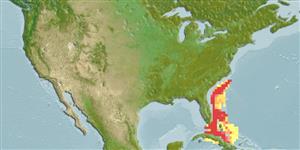Elasmobranchii (haaien en roggen) (sharks and rays) >
Torpediniformes (Electric rays) >
Narcinidae (Numbfishes)
Etymology: Benthobatis: Greek, benthos = depth of the sea + Greek, batis, -idos = a ray (Raja sp.) (Ref. 45335); marcida: From its loose skin and soft aspect ['marcidus' = withered or wasted]..
Environment: milieu / climate zone / depth range / distribution range
Ecologie
marien bathydemersaal; diepte 200 - 923 m (Ref. 48493). Deep-water; 34°N - 21°N, 82°W - 74°W (Ref. 114953)
Western Central Atlantic. South Carolina, USA to northern Cuba.
Grootte / Gewicht / Leeftijd
Maturity: Lm ? range ? - ? cm
Max length : 50.0 cm WD mannelijk / geslacht onbekend; (Ref. 26340)
Korte beschrijving
Morfologie | Morfometrie
Narrow protractile mouth. Caudal is oval shape. Greater length of head anterior to spiracles, union of margins of its pelvic fins to their tips with the sides of the tail. Soft body and skin (Ref. 6902). Light brown to yellowish-brown dorsal color pattern; white to yellowish-white ventral color pattern, sometimes with distinct yellow markings on posterior ventral disc surface, ventral pelvic fin area, and around mouth. Caudal fin length much less than 1/2 length of tail, roughly equal to 1/5 length of tail; relatively more pronounced upper and lower lobes with lower strongly convex. Distance between dorsal and caudal fins about equal to distance between first and second dorsal fins. Snout relatively short, generally less than 1/3 in disc-length (24% of disc length in 43.5 cm TL female, 25% in 48.5 cm TL), but never much greater than 1/3 as in B. moresbyi (ca 40% in lectotype); disc more rounded, not as elongated as in B. moresbyi (Ref. 48493).
Inhabits neritic waters, on sandy bottoms (Ref. 557). Found on continental and insular slopes at 250-1,000 m depths; adults apparently at greatest depths (Ref. 114953). Solitary. Tiny eyes are covered with skin so that the species is blind (Ref. 557). Feeds on marine invertebrates. Both ovaries are functional in an adult female, with numerous small oocytes of ca. 2 mm in thin-walled uteri. Maturity size of males at ca. 16 cm TL; birth size at 8-9 cm TL (Ref. 114953).
Levenscyclus en paargedrag
Maturiteit | Voortplanting | Paaien | Eieren | Fecunditeit | Larven
Claro, R., 1994. Características generales de la ictiofauna. p. 55-70. In R. Claro (ed.) Ecología de los peces marinos de Cuba. Instituto de Oceanología Academia de Ciencias de Cuba and Centro de Investigaciones de Quintana Roo. (Ref. 26340)
Status op de Rode Lijst van het IUCN (Ref. 130435)
Gebruik door de mens
Visserij: van geen belang
Meer informatie
ReferentiesAquacultuurAquacultuurprofielKweeklijnenGeneticaElectrophoresesErfelijkheidZiektesVerwerkingNutrientsMassaconversie
Tools
Speciale rapporten
Download XML
Internetbronnen
Estimates based on models
Preferred temperature (Ref.
123201): 8.8 - 18.2, mean 13 °C (based on 77 cells).
Fylogenetische diversiteitsindex (Ref.
82804): PD
50 = 0.5625 [Uniqueness, from 0.5 = low to 2.0 = high].
Bayesian length-weight: a=0.01175 (0.00476 - 0.02897), b=2.88 (2.66 - 3.10), in cm total length, based on LWR estimates for this (Sub)family-body shape (Ref.
93245).
Trofisch niveau (Ref.
69278): 3.2 ±0.4 se; based on size and trophs of closest relatives
Weerstandsvermogen (Ref.
120179): laag, minimale populatieverdubbelingstijd 4,5-14 jaar (Assuming fecundity<100).
Fishing Vulnerability (Ref.
59153): Low vulnerability (20 of 100).
